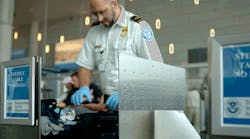The threat of terrorist attacks on American aviation has resulted in intense security efforts, but do the benefits outweigh the cost of such measures? Creating a focus on getting the most security for the least cost should be the priority in an era of fiscal austerity, according to a new RAND Corp. report.
The report, “Efficient Aviation Security: Strengthening the Analytic Foundation for Making Air Transportation Security Decisions,” details ways the federal Transportation Security Administration and Congress could better consider not only the risks posed by terrorists, but the cost effectiveness of security efforts to reduce those risks.
“Commercial aviation plays a central role in the national economy, and attacks on planes and airports have long been a threat by terrorists worldwide,” said Brian Jackson, a report co-author and a senior researcher at RAND, a nonprofit research organization. Other authors of the report are Tom LaTourrette, Edward W. Chan, Russell Lundberg, Andrew R. Morral and David R. Frelinger.
“But it has also become clear that the public’s tolerance for inconvenience and other security costs is not inexhaustible,” continued Jackson. “The benefits of aviation security must be weighed against the costs in providing that security.”
Among the key findings is that, while it is possible to add up how much money has been spent on scanners, screeners, and other security efforts, there are less-tangible economic costs resulting from the reality that a lot of security makes the aviation system more difficult to use.
“When the system being protected is as valuable economically as aviation, even a small reduction in its usefulness and value adds up quickly, making security potentially much more costly than might be assumed,” Jackson said.
Evolving Threats to Aviation Security
Evolving terrorist tactics and technology pose new threats to aviation security at the same time U.S. airline passengers are becoming increasingly hostile to the very measures employed to protect them. In “Aviation Security: After Four Decades, It’s Time for a Fundamental Review,” terrorism expert Brian Michael Jenkins argues that a fundamental review of how we secure the airplanes that 2 million passengers board every day in the United States is imperative.
Aviation security is costly, controversial and contentious, according to Jenkins, senior advisor to the president of RAND. Aviation dramatically demonstrates the basic tenet of terrorism: that small groups with a limited capacity for power can achieve disproportionate effects by using terrorist tactics.
Terrorists only have to recruit one bomber; the United States has to protect 450 commercial airports, with tens of thousands of flights daily and millions of passengers. And terrorists remain obsessed with attacking airplanes, even though recent security measures have made it more difficult.
But aviation security isn’t just about passenger safety, Jenkins said. It’s also a matter of national security. In 1988, when Pan AM flight 103 was blown up by a terrorist bomb, the United States did not take any military action against Libya. Today, however, acts of terrorism frequently result in a response from U.S. military.
Americans, Jenkins writes, are a “cantankerous bunch” who want “100 percent security but have little tolerance for inconvenience and will react with outrage to intrusions into their privacy.” They also prefer their security to be egalitarian – the same treatment for all passengers – which makes it difficult to adopt more selective screening measures, such as a “trusted traveler” program.
The report explores ways to inform decision-making despite uncertainties about the terrorist threat, security system performance and the costs of security measures. It also provides analysis that fills important gaps in the assessment of the costs, benefits and efficiency of aviation security measures and strategies.
Layered Aviation Security Measures Not Always Effective
Researchers write that America’s aviation system is protected by a layered security strategy that is sometimes, but not always, effective. Multiple types of security technology and other measures provide several lines of defense that must be breached for an attack to be successful. But this does not mean more layers are always better than fewer.
In some cases, layers can reinforce each other and be more effective than the sum of the individual measures on their own. In others, they can interfere with one another and provide less security together than they would have separately. For example, efforts by security officers to detect suspicious behavior at checkpoints could be made less effective if passenger agitation created by the experience of going through screening masks the indicators those officers attempt to detect. New layers on top of old are costly and can make the aviation system more difficult for passengers and other users.
Researchers found that “trusted traveler programs” – including the current TSA PreCheck program – are an attractive strategy for making security more efficient and reducing security burdens on some travelers.
While there has been concern that terrorists could masquerade as a trusted traveler and exploit the program, it is possible to show that overall security can improve even if some attackers compromise the program. However, this requires that the resources saved by reducing screening for trusted travelers are used to improve screening of the remaining members of the public. The effectiveness of a trusted traveler program also depends on high participation rates.

